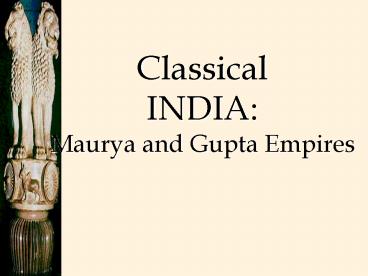Classical INDIA: Maurya and Gupta Empires - PowerPoint PPT Presentation
1 / 20
Title:
Classical INDIA: Maurya and Gupta Empires
Description:
Classical INDIA: Maurya and Gupta Empires * Noted Achievements: medicine (c-sections, inoculations); math (decimals, concept of zero and pi; astronomy (round earth ... – PowerPoint PPT presentation
Number of Views:195
Avg rating:3.0/5.0
Title: Classical INDIA: Maurya and Gupta Empires
1
ClassicalINDIAMaurya and Gupta Empires
2
Varna (Social Hierarchy)
What is a JATI?
Brahmins
Kshatriyas
Vaishyas
Shudras
Those with no caste? Untouchables
3
The Caste System
Brahmins
- SOCIAL CLASSES
- Purushas mouth
- arms
- legs
- feet
Kshatriyas
Vaishyas
Shudras
4
Maurya Gupta India
5
The Maurya Empire
321 BCE 185 BCE
6
CHANDRAGUPTA
- Chandragupta Maurya unified northern India.
Extremely centralized! - Divided empire into provinces districts
for tax assessments and law enforcement. - Feared assassination ? food tasters, slept in
different rooms, etc. - 301 BCE ? gave up his throne became
a Jain (religion focusing on complete
non-violence).
7
Kautilya
- Chandraguptas advisor.
- Wrote the Arthashastra
- A guide for the king and his ministers
- Supports royal power.
- The great evil in society is anarchy.
- Therefore, a single authority is needed to
employ force when necessary!
8
Ashoka 304-232 BCE
- Ashoka most important
- ruler of Maurya
- Religious conversion after gruesome battle
of Kalinga - religiously tolerant
- Patronized Buddhism
- Put up pillars all over India, declaring the
peaceful intent of his empire
9
Mauryan Empire under Ashoka HUGE!
10
Ashokas law code
- Written mostly in Sanskrit, but one was in
Greek and Aramaic - Cosmopolitan (diverse)
- empire!
- Buddhist principles dominate his laws.
- Focus on nonviolence, morality, religious
toleration - Note the pillar on the left!
11
Turmoil a power Vacuum220 BCE 320 CE
Tamils
The Mauryan Empire gets divided into many kingdoms
12
Gupta Empire 320 CE 647 CE
13
Gupta Rulers
- Profitable trade of cotton pepper
- Guptas were Hindu, not Buddhists
- Buddhism began to merge back within Hinduism
(Buddha became just another Hindu god) - Less centralized smaller than Mauryan
- Theater State Cultural dominance
14
Xuanzang Life in Gupta India
- Chinese Buddhist monk traveled along the Silk
Roads and visited India in the 5c. - He was following the path of the Buddha.
- He reported the people to be happy,
relatively free of government oppression, and
inclined towards courtesy and charity.
Other references in the journal, however,
indicate that the caste system was rapidly
assuming its basic features, including
"untouchability," the social isolation of a
lowest class that is doomed to menial labor.
15
Empire under Chandra Gupta II
16
International Trade Routes during the Guptas
17
Extensive Trade
spices
silks
cotton goods
spices
horses
cotton
18
GuptaArt
Greatly influenced Southeast Asian art
architecture.
19
1000 diseasesclassified
500 healingplants identified
Gupta Achievements
Printedmedicinal guides
Medicine
PlasticSurgery
GuptaIndia
Inoculations
C-sectionsperformed
SolarCalendar
Astronomy
Mathematics
DecimalSystem
The earthis round
PI 3.1416
Conceptof Zero
20
The Decline of the Guptas
- Invasion by White Huns in the 500s end of the
Gupta Golden Age - decline of Gupta empire - north India broke into
many separate Hindu kingdoms ruled by rajputs
(Hindu princes) - Indian History is marked by a big debate Unity
vs. Disunity































